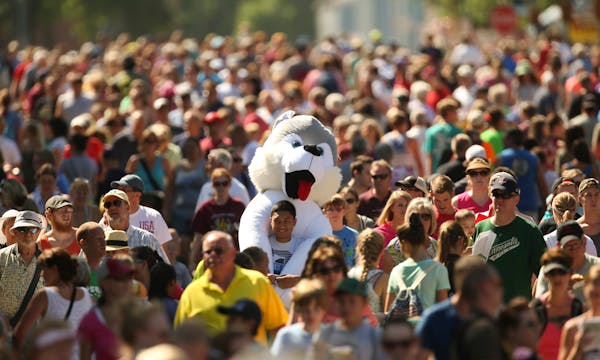How much of what we toss in recycling bins is actually getting recycled?
China's decision to stop accepting America's dirty recycling has rocked the waste industry and forced some communities across the country to landfill material tossed in the big blue bins. So is recycling still worth it here in Minnesota?
That was weighing on the minds of two people who submitted questions to Curious Minnesota, our community-driven reporting project fueled by great questions from readers. One asked what percent of Twin Cities sorted recyclables are actually recycled. Another wondered whether most of it is just sent to the dump.
Minnesota was not spared the ripple effects of the global disruption, which has sent prices for some recyclable materials plummeting due to an oversupply in domestic markets. Many cities are paying more for recycling programs as a result, but all those bottles, cans, newspapers and other recyclable materials are still being recycled.
In fact it is illegal in Minnesota for waste facilities to bury or burn recycled materials unless the Minnesota Pollution Control Agency (MPCA) determines no one else can take them — which has never happened.
"We have statutes in place that protect recycling," said Mark Rust, supervisor of the MPCA division that handles solid waste. "And the idea is that if you put something out at the curb, or drop something off at a recycling facility, that there needs to be a certain guarantee that that material is actually going to be recycled."
Rust said they occasionally hear comments from people who say, "I don't really care about recycling because it just gets thrown away anyway." That has happened to some degree in other places like Oregon, which has had to dump 16,000 tons of recyclables since 2017 — about two percent of what was collected. A garbage burner outside Philadelphia is accepting 200 tons of recyclables a day, according to a report in the Guardian. But it's not happening in Minnesota.
"We work very hard ... to dispel that myth," Rust said.
That said, the recycling system is not perfect. State law says sorting centers must recycle at least 85 percent of what they accept to avoid paying the state's solid waste tax. That means they can count up to 15 percent as "residue" that is not recycled. Bill Keegan, president of Shakopee-based Dem-Con Companies, said the residual rate among Minnesota recycling facilities is typically between 8 and 10 percent.
Most of that residual material can't be recycled, however.
Kate Davenport, co-president of Eureka Recycling, said their residue includes a lot of non-recyclable items like toaster ovens, garden hoses and Christmas lights that people toss in the recycling bin. It also includes "fines" like grit and grime picked up in the hauling process, as well as other items too small to be recycled properly.
The last portion of it is recyclable items that weren't properly caught by the system, such as an aluminum can compressed into a piece of cardboard.
Davenport said their residual rate — which is between 7 and 8 percent — has grown with the transition to single-sort recycling and then from bins to larger carts. But she added that the state's residual rates are very low compared with the rest of the country.
"The rest of the country's residual rates tend to average somewhere between 20 and 30 percent," Davenport said. "So we do a lot better job here in Minnesota."
Keegan said only about 1 percent of the waste coming into their Shakopee sorting center is recyclable material that takes a wrong turn somewhere in the process and isn't recycled. He said the bigger picture problem is all the recyclable items that are getting tossed in the trash.
"We want to capture all the other recyclables that are not being put in the recycling bin," Keegan said.
Some facilities are trying to recover those trashed recyclables. Ramsey and Washington counties force haulers serving those areas to bring trash to a processing facility they own in Newport, where some recyclable materials are pulled out. It yanked more than 14,000 tons of metal from the trash last year.
---
If you'd like to submit a Curious Minnesota question, fill out the form below:
Read more Curious Minnesota stories:
How did these 11 Minnesota towns get their unusual names?
Has Minnesota every had a major earthquake?
How did the Twin Cities become a hub for Somali immigrants?
Why was Minneapolis' mansion street destroyed, but St. Paul's survived?
Why won't anyone in Minnesota take the last piece of food?
Is Minnesota's tiny Lake Itasca the true source of the Mississippi River?
Why isn't Isle Royale a part of Minnesota?
Why is Uptown south of downtown in Minneapolis?


